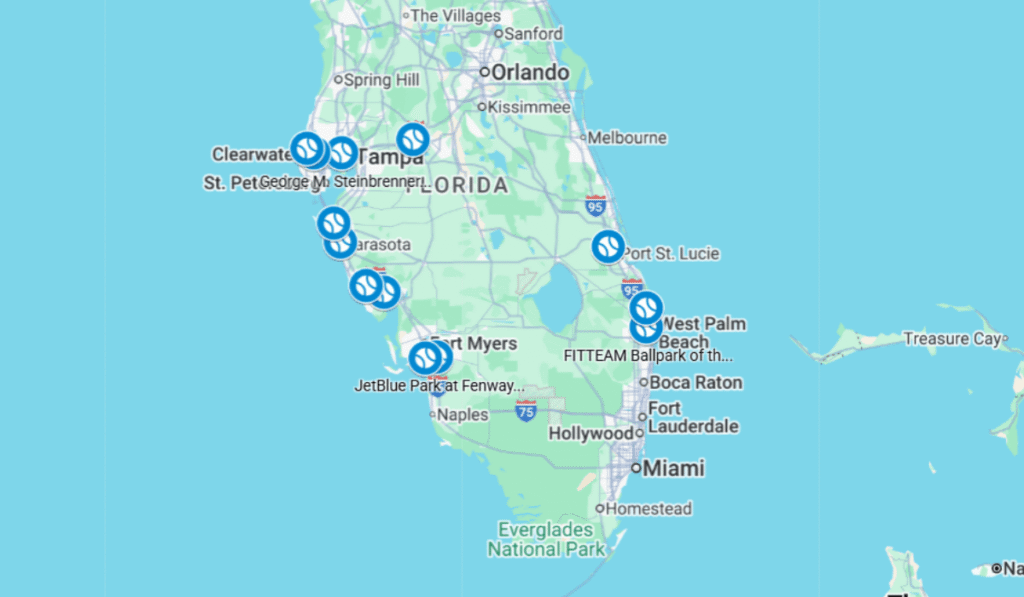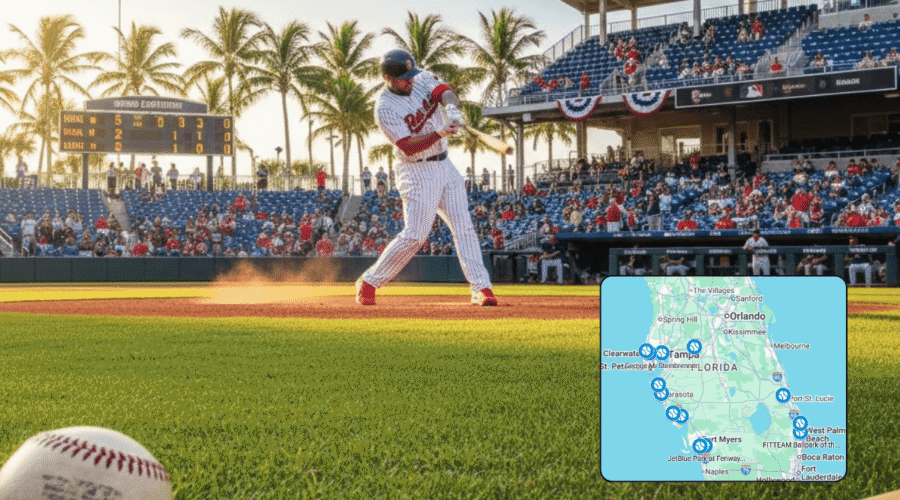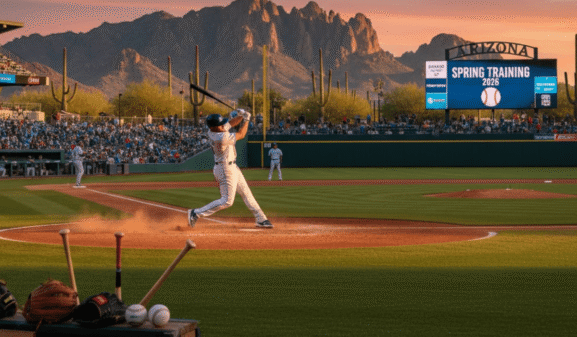Florida Spring Training Locations 2026: Map, Teams & Travel Tips
Picture this: you’re sitting in the third row behind home plate on a warm February afternoon, watching future Hall of Famers take batting practice just feet away, all for about the price of a movie ticket. This is the magic of Florida spring training — baseball’s most accessible and affordable experience — and 2026 promises another season of sun-soaked games across the Sunshine State’s Grapefruit League. (Note: stadium assignments and temporary relocations sometimes change year-to-year — for example, the Tampa Bay Rays played home games at Steinbrenner Field in 2025 while Tropicana Field underwent repairs — so always double-check individual team pages before booking.)
Whether you’re a die-hard fan planning your annual pilgrimage or a first-timer wondering how to navigate fifteen ballparks scattered across Florida’s coastlines, this comprehensive guide delivers everything you need to maximize your spring training adventure. We’ll map out the geographic clusters that make multi-game days possible, highlight the must-visit stadiums that consistently wow visitors, and share insider tips that transform a simple road trip into an unforgettable baseball experience. From understanding how the Grapefruit League’s layout creates natural travel routes to discovering which ballparks offer the best player access and family amenities, you’ll walk away with a strategic, map-based plan that saves time, money, and frustration.
Quick Takeaways
- Fifteen MLB teams train across Florida’s Grapefruit League, organized into geographic clusters perfect for efficient day trips
- Three practical hubs — Fort Myers, the greater Tampa/St. Petersburg area, and the Jupiter/Port St. Lucie/Palm Beach corridor — each feature multiple ballparks within roughly an hour’s drive. (Note: venue assignments can change — e.g., the Rays played at Steinbrenner Field in 2025 during Tropicana Field repairs; check team pages for the latest.)
- JetBlue Park (Fort Myers) and Roger Dean Chevrolet Stadium (Jupiter) are regularly recommended for family experiences and player access.
- Map-based planning reduces driving time substantially by grouping games within coastal regions rather than crisscrossing the state
- Mid-week games offer smaller crowds and better parking, while the typical season runs late February through mid-March
- Arrive early for batting practice access—most stadiums allow fans near the field for autographs and photos before first pitch
How the Grapefruit League Map is Organized
Understanding Florida’s spring training geography transforms an overwhelming list of fifteen teams into manageable travel clusters. The Grapefruit League spreads teams along Florida’s Gulf and Atlantic coastlines, plus a few strategic inland locations, creating natural groupings that make a map-based approach absolutely essential for efficient trip planning.
MLB’s official Grapefruit League map reveals the full footprint and immediately clarifies why savvy fans choose two- or three-ballpark days rather than attempting to cross the peninsula in a single exhausting drive. The layout naturally divides into three primary regions: the Gulf Coast corridor running from Tampa through Fort Myers, the Central Florida zone connecting Lakeland with the Orlando area, and the Atlantic corridor stretching from West Palm Beach through Jupiter to Port St. Lucie.
This geographic organization isn’t accidental—teams deliberately cluster near similar spring training competitors to facilitate exhibition matchups while keeping travel logistics simple for visiting fans. The result? You can often catch an afternoon game in one city, grab dinner, and still make a twilight game thirty minutes down the road.
Quick Regional Breakdown
Gulf Coast / Fort Myers–Tampa Cluster: Fort Myers hosts the Boston Red Sox (JetBlue Park at Fenway South) and the Minnesota Twins (Hammond Stadium); the New York Yankees train at George M. Steinbrenner Field in Tampa; the Toronto Blue Jays are at TD Ballpark (Dunedin); and the Philadelphia Phillies are at BayCare Ballpark (Clearwater). These venues form a practical weekend loop along Florida’s western coast.
Greater Tampa–Bradenton Zone: The Baltimore Orioles train at Ed Smith Stadium (Sarasota), and the Pittsburgh Pirates at LECOM Park (Bradenton); the Tampa Bay Rays conduct spring work at Charlotte Sports Park (Port Charlotte) — note the Rays’ broader stadium situation has been in flux because of Tropicana Field repairs and a temporary relocation in 2025.
Atlantic Corridor (Palm Beach County to Port St. Lucie): The Houston Astros and Washington Nationals share the West Palm Beach complex now called CACTI Park of the Palm Beaches; Roger Dean Chevrolet Stadium (Jupiter) is home to the Miami Marlins and the St. Louis Cardinals; and the New York Mets train at Clover Park (Port St. Lucie).
Central Florida Connection: The Detroit Tigers remain at Publix Field at Joker Marchant Stadium (Lakeland), and the Atlanta Braves play at CoolToday Park (North Port), which also helps bridge Gulf- and central-Florida travel loops.
This regional structure means your map becomes your most valuable planning tool—highlight your target teams, circle the ballparks, and suddenly the logistics become crystal clear.
Key Ballparks & Why They’re Worth Visiting
If you’re building an itinerary from a map of Florida spring training locations, certain stadiums consistently earn rave reviews for their unique features, fan experience, and overall atmosphere. These venues represent the best the Grapefruit League offers, each delivering something special beyond just watching baseball.
JetBlue Park at Fenway South (Fort Myers) tops most recommendation lists for good reason. The Boston Red Sox recreated Fenway Park’s iconic left-field Green Monster, complete with authentic dimensions and a hand-operated scoreboard. The result is a nostalgic paradise for Red Sox fans and baseball purists alike, offering those legendary Fenway sightlines in a sunny, spacious setting. The facility consistently draws praise for its lively fan atmosphere, excellent photo opportunities, and proximity to Fort Myers Beach—perfect for combining baseball with Gulf Coast relaxation.
Roger Dean Chevrolet Stadium (Jupiter) earns its reputation as perhaps the most family-friendly spring training venue in Florida. This shared facility hosts both the Miami Marlins and St. Louis Cardinals, meaning you’ll find games scheduled nearly every day throughout spring training. The stadium features dedicated family zones with kid-friendly activities, excellent sightlines from every seat, and that rare combination of professional-quality facilities with intimate, minor-league charm. Parents especially appreciate the reasonable concession prices and the stadium’s walkable surroundings.
CoolToday Park (North Port) represents the newest generation of spring training facilities. The Atlanta Braves’ modern complex, opened in 2019, showcases state-of-the-art fan amenities including shaded seating areas (crucial for Florida’s intense sun), diverse food options, and adjoining minor-league practice fields where fans can watch prospects develop. The architectural design prioritizes airflow and comfort while maintaining that close-to-the-action feel that makes spring training special.
Publix Field at Joker Marchant Stadium (Lakeland) delivers practical value for families visiting Central Florida. Located conveniently between Tampa and Orlando, this Detroit Tigers facility makes it easy to mix a theme-park vacation with authentic baseball. The recently renovated ballpark combines modern conveniences with old-school spring training character, and the Tigers’ fan-friendly policies make it particularly welcoming for first-time spring training visitors.
These venues appear repeatedly on experienced travelers’ itineraries because they’ve mastered the spring training formula: accessible players, reasonable prices, quality facilities, and that relaxed atmosphere that separates February baseball from the regular season’s intensity.
read more: When Does Spring Training Start in 2026? Florida & Arizona Baseball
How to Use the Map: Practical Itineraries & Tips

Click here to see the actual Florida Grapefruit League official map
Map-driven planning transforms what could be a chaotic schedule into a smooth, enjoyable trip with minimal wasted time in the car. Here are three proven itineraries you can trace directly on a Grapefruit League map, plus actionable tips that veterans swear by.
Fort Myers Weekend (Two to Three Games): Base yourself in Fort Myers and hit both JetBlue Park (Red Sox) and Hammond Stadium (Twins). These ballparks sit just miles apart, making a doubleheader day entirely feasible—catch a 1:05 p.m. first pitch at one venue, then head to the other for a 6:05 p.m. twilight game. Between games, you’ve got time for Fort Myers Beach, the Edison and Ford Winter Estates, or simply relaxing by your hotel pool. The area offers excellent lodging options at every price point, and the compact geography means you’re never fighting traffic.
Tampa Bay Loop (Ambitious Day Trip): Start early at Steinbrenner Field to watch the Yankees, then head north to Dunedin for the Blue Jays’ afternoon game, and if you’re truly ambitious, cap the day in Clearwater watching the Phillies. This route requires discipline with timing and traffic awareness—use parking shuttles where available to avoid circling packed lots—but the payoff is three distinct ballpark experiences showcasing different eras of spring training architecture, all within roughly fifty miles.
Atlantic Corridor Day: Begin at Roger Dean Stadium in Jupiter for morning or early-afternoon baseball (remember, this shared facility often hosts back-to-back games from different teams), then cruise north on I-95 or the more scenic A1A to Clover Park in Port St. Lucie for an evening Mets game. The minimal highway time keeps stress low, and both ballparks maintain extensive minor-league practice facilities where early arrivals can watch future stars working on fundamentals.
Actionable Travel Tips That Actually Work
Book tickets strategically: Weekend marquee matchups—especially Red Sox vs. Yankees or any opening weekend games—sell out quickly. Check team calendars when they’re posted (typically December or early January) and reserve seats for weekend games immediately. Midweek games often have walk-up availability and smaller crowds, making them ideal for spontaneous visits or families with young children.
Maximize player access: Spring training’s greatest advantage over regular-season games is proximity to players. Arrive at least ninety minutes before first pitch to watch batting practice from the outfield berm or along the baselines, where teams often allow fans. Follow each team’s specific autograph policies—some designate certain areas and times for signings, while others allow more casual interactions. Bring a baseball (preferably new) and a fine-point Sharpie; players are far more likely to sign proper equipment than random items.
Master parking logistics: Each ballpark publishes parking and shuttle information on its official page, accessible through MLB’s Grapefruit League directory. Study these before you go—some stadiums offer free off-site parking with convenient shuttle service, while others require prepaid parking passes. For multi-game days, factor in fifteen to twenty minutes for parking and walking to your seat, especially at larger venues like Steinbrenner Field or JetBlue Park.
Pack appropriately: Florida in February and March swings between perfect seventy-degree afternoons and surprisingly cool, breezy evenings. Bring layers, quality sunscreen (you’ll burn faster than you expect, even on cloudy days), a hat with a brim, and comfortable walking shoes. Many ballparks sell shade seat upgrades—often worth the extra ten dollars if you’re attending an afternoon game.
Evidence & Impact: Why Communities Invest in Spring Training
Spring training represents far more than warm-weather baseball—it’s serious business for Florida communities. The Grapefruit League drives substantial tourism and community spending each spring, with cumulative attendance regularly exceeding one million fans across the fifteen facilities. Recent Florida Grapefruit League economic impact reports cite hundreds of millions in direct spending on hotels, restaurants, rental cars, and local attractions, demonstrating why counties compete aggressively to attract and retain MLB teams.
This financial reality translates into tangible benefits for visitors: communities continuously upgrade facilities, maintain reliable public transit options near stadiums, and program frequent fan events beyond games themselves. Municipalities understand that spring training success depends on positive visitor experiences, which explains the consistently well-maintained ballparks, responsive customer service, and family-friendly atmosphere that characterizes the Grapefruit League.
For trip planners, these investments mean you can count on professional-quality experiences even at smaller-market sites, with infrastructure designed specifically to accommodate out-of-town visitors. The economic importance of spring training essentially guarantees that your experience will be well-organized and welcoming.
Conclusion
A properly utilized Florida spring training locations map transforms good intentions into a genuinely great trip by helping you cluster games strategically, minimize unproductive drive time, and maximize authentic ballpark experiences. Start with MLB’s official Grapefruit League map and individual team pages to lock in specific venues and schedules, then apply the regional itinerary suggestions outlined above to create realistic daily plans.
Whether you’re following a single favorite team throughout their spring schedule or attempting to collect as many different stadiums as possible, Florida’s spring training footprint delivers exactly what makes baseball special: the game’s fundamentals showcased in compact, varied, and genuinely fan-focused environments. Major league talent meets minor league intimacy, creating a unique February and March tradition that loyal fans return to year after year.
Pack your sunscreen, build your map-based plan with those geographic clusters in mind, and leave ample buffer time for batting practice wanderings, unexpected autograph opportunities, and those spontaneous conversations with fellow fans that become the trip’s best memories. You’ll return home with exceptional photos, closer seat memories than you’d ever get during the regular season, and quite possibly a baseball signed by your childhood hero.
Frequently Asked Questions
Where are the MLB spring training sites in Florida?
Florida’s Grapefruit League ballparks run from the Tampa Bay area south through Fort Myers and along the Atlantic corridor from West Palm Beach through Jupiter to Port St. Lucie, plus central locations like Lakeland. MLB’s official Grapefruit League interactive map lists all fifteen stadium locations with addresses and directions, making it simple to plot routes between venues based on your home base and target teams.
How many baseball teams are in Florida for spring training?
The Grapefruit League comprises exactly fifteen MLB teams training in Florida each spring, split between Gulf Coast and Atlantic Coast locations. This concentration creates the geographic clusters that make multi-game road trips feasible and explains why Florida spring training has become such a popular winter vacation destination for baseball fans nationwide.
Where is the Cactus League spring training?
The Cactus League operates entirely in Arizona, concentrated in the Phoenix metropolitan area across cities including Scottsdale, Mesa, Glendale, Peoria, Surprise, Goodyear, and Tempe. Ten MLB teams train in Arizona’s desert climate, creating a separate spring training ecosystem from Florida’s Grapefruit League. MLB’s official Cactus League map provides stadium locations and details for fans planning Arizona-based spring training trips.
When does spring training typically run in Florida?
Pitchers and catchers generally report to Grapefruit League facilities in mid-February, with full-squad workouts beginning shortly after. Exhibition games typically start during the final week of February or first few days of March, running through late March just before Opening Day. For 2026 specific dates, check SpringTrainingOnline and individual team spring training pages beginning in late 2025, as precise reporting dates and game schedules are typically announced in December or January.
Can I visit multiple stadiums in one day?
Absolutely—if you choose geographically clustered teams and plan around game times strategically. The Fort Myers pair (Red Sox and Twins), the Tampa–Clearwater–Dunedin trio, and the Jupiter–Port St. Lucie Atlantic corridor all make same-day doubleheaders or even tripleheaders realistic with proper timing. Use your Grapefruit League map to calculate realistic driving windows, factor in parking logistics at each venue, and verify start times to ensure you’re not attempting an impossible schedule that leaves you racing between ballparks instead of enjoying the games.


